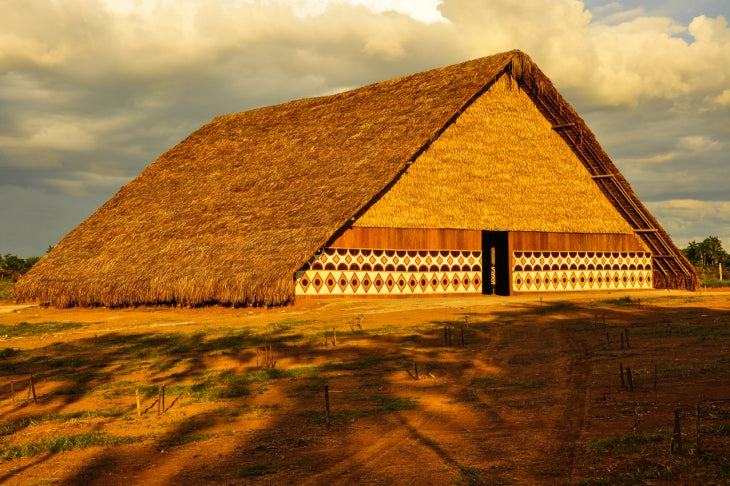By Maria Angella Fortich Fraija
Indigenous communities have inhabited Colombia since before the Spanish arrived in the 15th century. The indigenous families that inhabited the Colombian territory were the Caribbean , located on the coast of the Atlantic Ocean; the Chibcha , located in the highlands and cold areas in the center of the country and in the Sierra Nevada de Santa Marta, and finally, the Arawak culture , in the region of the Amazon River, Putumayo and Caquetá.
Generation after generation have passed their knowledge and their life cycle through nature. One of those traditions is the construction of malocas and the meaning behind them. But... what is a maloca?
What is a maloca?
The malocas are a traditional "home" for family and/or communal use built by indigenous peoples in the Amazon of Colombia, Brazil, Ecuador and Peru.
The malocas represent a unit of traditional society. Your home symbolizes the tuning of the universe . The malocas reflect and are built through the memory and cosmology of the indigenous people that have been woven in their constant relationship with nature.
According to the Colombian Ministry of Culture, this divine archetype personalizes the womb of Mother Earth , the house of the sun and the moon, or the receptacle of heavenly lightning. In it, knowledge is transmitted, contact is made with individual spirituality, on the other hand, it is also a political place where decisions are made for the community.

photo taken from Cuac editorial
Structure of the malocas
In the highest part of the malocas there is a space formed by four central beams , in this area the world of knowledge is represented, in the central part the center of the universe is reflected and a space reserved for male reflection.
In the second space the pillars are joined and the instrumental and musical world is considered. The space between the minor beams and the outer edge represents the world of vultures, there is a special area for rituals and dances despite being intended for daily activities for men and women.
The American ethnologist, Martin Von Hildebrand , expresses that between the minor beams and the outer edge there is a space reserved for the masculine-feminine transition represented in alliances. This can be seen in the marriage of indigenous people with different malocas or with other ethnic groups. Additionally, around the malocas are located the chagras managed mainly by women, and then extends the jungle that is protected by the spiritual guardians.

photo taken from Gaia:
https://www.gaiaamazonas.org/noticias/2019-05-31_la-maloca-el-mundo-de-la-casa-grande
Types of malocas
The design of the maloca depends on the community, it can be circular or square. In the case of the Pirá Paraná and Apaporis communities, the construction of the malocas continues to be guarded by the knowledgeable and maintains its rectangular plan, while in other communities its structure is circular.
All this process is based on the legends and myths passed down from the knowledge acquired from the first men. All the malocas are unique and have a different personification depending on what the experts will interpret from these stories.

How do you calculate the time inside the maloca?
Throughout time, the indigenous people have created everything in their society to be able to connect with nature and the malocas have been an essential tool for that. In them there is a deep connection between everyday life, space, time and the cosmos. Two triangular holes are made at the top, one facing east and the other facing west, thus producing a sundial . In the morning, the sun illuminates the upper area of the maloca and as it gets darker or the day goes by, the sun's rays fall and illuminate the owner's bench with the four main beams.
At noon it has an almost magical effect and it is when the sun is at its highest, between music and knowledge, no light enters the maloca and when evening falls again, it comes back and lights up.
sun calendar
The construction of the malocas also works as a solar calendar that guides the indigenous peoples on what times are the best to carry out crops or some rituals. This is analyzed by the movement of the earth, in the month of June, the sun changes its angle to the north in the equator area at 23.5 degrees and in the month of December 23.5 degrees to the south.
The sun settles on the equator in March and September, in this season they are at the time of the equinox , which means that the sun moves from the owner's seat in the west, passing through the center until it reaches the eastern side (the entrance of the maloca).

photo taken from Gaia:
https://www.gaiaamazonas.org/noticias/2019-05-31_la-maloca-el-mundo-de-la-casa-grande
For the indigenous people of the Colombian Amazon, the maloca is a model of the cosmos, it looks and feels like a temple since knowledge is expressed there , allowing a deeper connection with nature. They feel the responsibility of caring for Planet Earth and are aware that certain customs of human beings can deteriorate Mother Earth, therefore, through the malocas they honor nature and connect with the universe, balancing any external damage that occurs external to the community.
Indigenous culture is in charge of balancing and nurturing our bond with nature, which is why it is necessary to take care of our communities, especially that of the Amazon, so that the cultural development that we have gone through is not lost. Likewise, these traditions help care for the environment, helping to mitigate the current climate crisis.
All these traditions are part of our history and our growth as Colombia, which makes them essential so that our country can evolve and be a better home for all of us.




Comments
Thank you for this information.